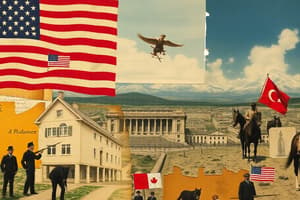Podcast
Questions and Answers
Who was responsible for purchasing the Alaskan Territory from Russia?
Who was responsible for purchasing the Alaskan Territory from Russia?
- Richard Olney
- William Seward (correct)
- Josiah Strong
- Napoleon III
What did Napoleon III do after the U.S. threatened to use force in Mexico?
What did Napoleon III do after the U.S. threatened to use force in Mexico?
Withdrew troops from Mexico
How much did the U.S. pay for Alaska?
How much did the U.S. pay for Alaska?
$7.2 million
What does 'New Imperialism' refer to?
What does 'New Imperialism' refer to?
What did the term 'international Darwinism' imply?
What did the term 'international Darwinism' imply?
Who was Josiah Strong?
Who was Josiah Strong?
What did Alfred Thayer Mahan advocate for?
What did Alfred Thayer Mahan advocate for?
What was the purpose of the Pan American Conference?
What was the purpose of the Pan American Conference?
What did James Blaine argue for?
What did James Blaine argue for?
What was Richard Olney authorized to do regarding Venezuela?
What was Richard Olney authorized to do regarding Venezuela?
What did the jingoism refer to?
What did the jingoism refer to?
Who was Valeriano Weyler?
Who was Valeriano Weyler?
What is yellow journalism?
What is yellow journalism?
What was the main conflict in the Spanish American War?
What was the main conflict in the Spanish American War?
What did the De Lome Letter criticize?
What did the De Lome Letter criticize?
What caused the explosion of the USS Maine?
What caused the explosion of the USS Maine?
What did the Teller Amendment promise?
What did the Teller Amendment promise?
Who was George Dewey?
Who was George Dewey?
What did the Rough Riders do?
What did the Rough Riders do?
What was the issue surrounding Philippine annexation?
What was the issue surrounding Philippine annexation?
Who was Emilio Aguinaldo?
Who was Emilio Aguinaldo?
What happened to Hawaii in 1900?
What happened to Hawaii in 1900?
What did the Anti-Imperialist League advocate?
What did the Anti-Imperialist League advocate?
What did the Insular Cases determine?
What did the Insular Cases determine?
What was the Platt Amendment?
What was the Platt Amendment?
Who was John Hay?
Who was John Hay?
What are spheres of influence?
What are spheres of influence?
What was the Open Door Policy?
What was the Open Door Policy?
What is xenophobia?
What is xenophobia?
What was the Boxer Rebellion?
What was the Boxer Rebellion?
What was Theodore Roosevelt's big stick policy?
What was Theodore Roosevelt's big stick policy?
What did the Hay-Pauncefote Treaty allow?
What did the Hay-Pauncefote Treaty allow?
What was the Panama Canal?
What was the Panama Canal?
Who was George Goethals?
Who was George Goethals?
Who helped eradicate Yellow Fever in Panama?
Who helped eradicate Yellow Fever in Panama?
What are the ABC Powers?
What are the ABC Powers?
Who was Pancho Villa?
Who was Pancho Villa?
What did the Tampico incident involve?
What did the Tampico incident involve?
What was Woodrow Wilson's New Freedom?
What was Woodrow Wilson's New Freedom?
What was moral diplomacy?
What was moral diplomacy?
What was the Jones Act?
What was the Jones Act?
Who was Victoriano Huerta?
Who was Victoriano Huerta?
What did Wilson do after the Tampico incident?
What did Wilson do after the Tampico incident?
What was the purpose of the expeditionary force?
What was the purpose of the expeditionary force?
Who was John J. Pershing?
Who was John J. Pershing?
Flashcards are hidden until you start studying
Study Notes
Key Figures in U.S. Expansion
- William Seward: Secretary of State who purchased Alaska from Russia for $7.2 million, enhancing U.S. territory.
- Napoleon III: French Emperor who withdrew troops from Mexico due to U.S. military threats.
- James G. Blaine: Advocated for U.S. leadership in Latin America and organized the Pan-American Conference.
- Richard Olney: As Secretary of State, he asserted the Monroe Doctrine in the Venezuela boundary dispute.
- Valeriano Weyler: Spanish General known for his brutal tactics in Cuba, earning the nickname "Butcher".
Key Events and Policies
- Alaska Purchase: Also known as "Seward's Folly", a strategic acquisition that expanded the U.S. West.
- Spanish-American War (1898): Conflict driven by U.S. support for Cuban independence and fueled by yellow journalism.
- De Lome Letter: A leaked Spanish ambassador's letter that criticized President McKinley and inflamed public sentiment for war.
- Maine Explosion: The sinking of a U.S. battleship in Havana Harbor that sparked calls for war against Spain.
- Teller Amendment: Legislation ensuring the U.S. would not annex Cuba post-war.
U.S. Imperialism and Foreign Relations
- New Imperialism: Describes the late 19th and early 20th-century wave of colonial expansion by Western powers, including the U.S.
- International Darwinism: The idea that nations must compete for resources and territories to demonstrate strength.
- Jingoism: An extreme nationalist sentiment pushing for aggressive military policies.
- Anti-Imperialist League: An organization opposing U.S. expansion and imperialism.
U.S. Policies and Agreements
- Open Door Policy: Promoted equitable trade in China, ensuring no single nation monopolized Chinese markets.
- Big Stick Policy: Roosevelt's diplomatic approach of negotiating peacefully while leveraging military power if necessary.
- Dollar Diplomacy: Taft's strategy of using economic power to influence foreign affairs, particularly in Latin America and the Caribbean.
Key Conflicts and Military Actions
- Boxer Rebellion: Anti-foreign uprising in China that the U.S. intervened in to protect its interests.
- Panama Canal: Constructed from 1904-1914 to facilitate maritime trade between the Atlantic and Pacific Oceans.
- Mexican Civil War: Wilson refused to support Huerta's dictatorship, resulting in increased tensions with Mexico, including the Tampico incident.
- Pancho Villa Expedition: U.S. military pursuit of the revolutionary leader Villa, highlighting tensions in U.S.-Mexico relations.
Legislative and Political Developments
- Platt Amendment: Restricted Cuban sovereignty and allowed U.S. intervention in Cuban affairs.
- Jones Act: Established a path to independence for the Philippines once a stable government was achieved.
- Gentlemen's Agreement: An accord between the U.S. and Japan to limit Japanese immigration in exchange for the repeal of discriminatory laws.
Important Treaties and Conferences
- Treaty of Portsmouth: Ended the Russo-Japanese War; Roosevelt's mediation earned him a Nobel Peace Prize.
- Hay-Pauncefote Treaty: Granted the U.S. rights to construct and control a Central American canal without British involvement.
- Root-Takahira Agreement: Established mutual respect for territories in the Pacific and support for the Open Door policy.
Notable Policies and Their Impact
- Moral Diplomacy: Wilson's approach that emphasized human rights and democracy over military intervention.
- Lodge Corollary: Expanded the Monroe Doctrine to exclude non-European powers from the Western Hemisphere.
Studying That Suits You
Use AI to generate personalized quizzes and flashcards to suit your learning preferences.





